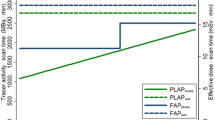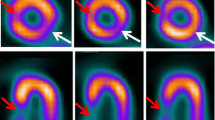Abstract
Background
Recent technological advances in myocardial perfusion imaging may warrant the use of lower injected activity. We evaluated whether quantitative measures of stress myocardial perfusion defects using Tc-99m sestamibi and low-energy high-resolution (LEHR) collimators are equivalent to lower dose SPECT-CT with cardiac multifocal collimators and software (IQ·SPECT).
Methods
93 patients underwent one-day rest-stress gated SPECT-CT. Following conventional rest imaging, 925-1100 MBq (25-30 mCi) of Tc-99m sestamibi was injected during stress testing. Stress SPECT-CT images were acquired two ways: with LEHR (13 minutes) and IQ·SPECT (7 minutes). Low-dose IQ·SPECT stress was simulated by subsampling the full-dose data to half-, quarter-, and eighth-count levels. Abnormalities were quantified using the total perfusion deficit (TPD) score and dose-specific databases.
Results
The mean ± SD of the differences between LEHR and IQ·SPECT TPD scores were −1.01 ± 5.36%, −0.10 ± 5.81%, 1.78 ± 4.81%, and 1.75 ± 6.05% at full, half, quarter, and eighth doses, respectively. Differences were statistically significant for quarter and eighth doses. Correlation between LEHR and IQ·SPECT was excellent at all doses (R ≥ 0.93). Bland-Altman plots demonstrated minimal bias.
Conclusions
With IQ·SPECT, quantitative stress SPECT-CT imaging is possible with half of the standard injected activity in half the time.
Resumen
Antecedentes
Los recientes avances tecnológicos en la imagen de perfusión miocárdica (MPI) pueden justificar el uso de una menor actividad inyectada. Nosotros evaluamos si las mediciones cuantitativas de los defectos de perfusión en estrés usando Tc-99m sestamibi y colimadores de baja energía y alta resolución (LEHR) son equivalentes a dosis menores en SPECT-CT con colimadores multifocales y programa de procesamiento cardiacos (IQ·SPECT).
Métodos
93 pacientes sometidos a gated SPECT-CT reposo – estrés en un solo día. Después de la imagen convencional de reposo, se inyectaron 925-1100 MBq (25-30 mCi) de Tc-99m sestamibi durante la prueba de estrés. Las imágenes de estrés con SPECT-CT se adquirieron de dos formas: con LEHR (13 min) y con IQ·SPECT (7 min). La dosis baja con IQ·SPECT fue simulada haciendo un submuestreo de los datos de la dosis completa a niveles de la mitad, la cuarta y la octava parte de las cuentas. Las anormalidades se cuantificaron usando el déficit total de perfusión (TPD) y bases de datos específicas por dosis.
Resultados
Las medias ± DE de las diferencias de los valores de TPD entre LEHR y IQ·SPECT fueron −1.01 ± 5.36%, −0.10 ± 5.81%, 1.78 ± 4.81% y 1.75 ± 6.05% a dosis completa, media, cuarta y octava parte, respectivamente. Las diferencias fueron estadísticamente significativas para la cuarta y octava parte de dosis. La correlación entre LEHR con IQ·SPECT fue excelente con todas la dosis (R > 0.93). Las gráficas de Bland-Altman demostraron mínimo sesgo.
Conclusión
Con IQ·SPECT, el estrés cuantitativo mediante la imagen de SPECT-CT es posible realizarlo con la mitad de la actividad estándar inyectada y en la mitad de tiempo.
摘要
背景
最近心脏灌注显像(MPI)的技术进步使得在较低注射剂量的条件下MPI成像变得可行。 本文评估:采用Tc-99m甲氧基异丁基异腈显影剂和低能量高分辨率准直器定量测定负荷状态下心肌血流灌注缺损(LEHR方法), 是否等效于采用心脏多焦点准直器和软件进行的较低剂量SPECT-CT的测定结果 (IQ·SPECT方法)。
方法
对入选的93个病人均采用负荷一日法/静息门控SPECT-CT 显影方案。 按照常规的方法进行静息图像的采集后, 在运动过程中静脉注射 925-1100 MBq(25-30mCi) 的 Tc-99m (甲氧基异丁基异腈)。 负荷SPECT-CT 图像是以两种方式采集:13分钟的LEHR和7分钟的 IQ·SPECT。 低剂量的负荷 IQ·SPECT是用全剂量样本的子样本来模拟, 分别是半剂量、 四分之一剂量和八分之一剂量。 用血流灌注缺损总积分(TPD)和剂量特征化数据库对心肌灌注异常进行定量。
结果
分别采用LEHR与IQ·SPECT方法时, TPD积分差值的平均值±标准方差是 −1.01 ±5.36%, −0.10 ± 5.81%, 1.78 ± 4.81% 和 1.75 ± 6.05%, 分别对应于全剂量、半剂量、 四分之一剂量和八分之一剂量。在四分之一和八分之一剂量时采用LEHR与IQ·SPECT方法测定的TPD差值在统计学上有显著性差异。在所有剂量段时采用LEHR与 IQ·SPECT 方法测定的TPD都有很好的相关性(R ≥ 0.93)。Bland-Altman图形表明了最小偏差。
结论
采用IQ·SPECT方法, 将图像采集时间和显影剂注射剂量都减半应用于负荷SPECT-CT成像是可行的。





Similar content being viewed by others
Abbreviations
- SPECT:
-
Single-photon emission computed tomography
- CT:
-
Computed tomography
- TPD:
-
Total perfusion deficit
- LEHR:
-
Low-energy high-resolution
- MPI:
-
Myocardial perfusion imaging
- PSF:
-
Point-spread function
- FWHM:
-
Full-width half-maximum
- OSEM:
-
Expectation maximization procedure with ordered subsets
- SSS:
-
Summed stress score
References
Fazel R, Krumholz HM, Wang Y, et al. Exposure to low-dose ionizing radiation from medical imaging procedures. N Engl J Med. 2009;361(9):849-57.
Chen J, Einstein AJ, Fazel R, et al. Cumulative exposure to ionizing radiation from diagnostic and therapeutic cardiac imaging procedures. JACC. 2010;56(9):702-11.
Piccinelli M, Garcia EV. Advances in software for faster procedure and lower radiotracer dose myocardial perfusion imaging. Prog Cardiovasc Dis. 2015;57(6):579-87.
Slomka PJ, Dey D, Duvali WL, Henzlova MJ, Berman DS, Germano G. Advances in nuclear cardiac instrumentation with a view towards reduced radiation exposure. Curr Cardiol Rep. 2012;14(2):208-16.
DePuey EG, Bommireddipalli S, Clark J, Thompson L, Srour Y. Wide beam reconstruction “quarter-time” gated myocardial perfusion SPECT functional imaging: A comparison to “full-time” ordered subset expectation maximum. J Nucl Cardiol. 2009;16(5):736-52.
Sharir T, Slomka PJ, Hayes SW, et al. Multicenter trial of high-speed vs conventional single-photon emission computed tomography imaging. JACC. 2010;55(18):1965-74.
Einstein AJ, Johnson LL, DeLuca AJ, et al. Radiation dose and prognosis of ultra-low-dose stress-first myocardial perfusion SPECT in patients with chest pain using a high-efficiency camera. J Nucl Med. 2015;56:545-51.
Nazakato R, Berman DS, Hayes SW, et al. Myocardial perfusion imaging with a solid-state camera: Simulation of a very low dose imaging protocol. J Nucl Med. 2013;54:373-9.
Vija AH, Malmin R, Yahil A, et al. A method for improving the efficiency of myocardial perfusion imaging using conventional SPECT and SPECT/CT imaging systems. In: IEEE Nuclear Science Symposium (NSS-MIC) Conf Record. 2010; p. 3433-3437.
Imbert L, Poussier S, Franken PR, et al. Compared performance of high-sensitivity cameras dedicated to myocardial perfusion SPECT: A comprehensive analysis of phantom and human images. J Nucl Med. 2012;53(12):1897-903.
Matsuo S, Nakajima K, Onoguchi M, Wakabayash H, Okuda K, Kinuya S. Nuclear myocardial perfusion imaging using thallium-201 with a novel multifocal collimator SPECT/CT: IQ·SPECT vs conventional protocols in normal subjects. Ann Nucl Med. 2015;29:452-9.
Caobelli F, Kaiser SR, Thackeray JT, et al. IQ SPECT allows a significant reduction in administered dose and acquisition time for myocardial perfusion imaging: Evidence from a phantom study. J Nucl Med. 2014;55:2064-70.
Wiuf C, Stumpf MPH. Binomial subsampling. Proc R Soc A. 2006;462:1181-95.
Hsiao EM, Cao X, Zurakowski D, et al. Reduction in radiation dose in mercaptoacetyltriglycerine renography with enhanced planar processing. Radiology. 2011;261(3):907-15.
Vija AH, Zeintl J, Chapman JT, Hawman EG, Hornegger J. Development of rapid SPECT acquisition protocol for myocardial perfusion imaging. In: Conference Record IEEE Nuclear Science Symposium and Medical Imaging Conference 2006, vol. 3, p 1811-1816.
Slomka PJ, Nishina H, Berman DS, et al. Automated quantification of myocardial perfusion SPECT using simplified normal limits. J Nucl Cardiol. 2005;12:66-77.
Diamond GA, Foster JS. Analysis of probability as an aid in the clinical diagnosis of coronary-artery disease. N Engl J Med. 1979;300:1350-8.
Grossman GB, Garcia EV, Bateman TM, et al. Quantitative Tc-99m sestamibi attenuation-corrected SPECT: Development and multicenter trial validation of myocardial perfusion stress gender-independent normal database in a obese population. J Nucl Cardiol. 2004;11(3):263-72.
ICRP, 1998. Radiation Dose to Patients from Radiopharmaceuticals (Addendum to ICRP Publication 53). ICRP Publication 80. Ann. ICRP 28 (3).
Zafrir N, Solodky A, Ben-Shlomo A, et al. Feasibility of myocardial perfusion imaging with half the radiation dose using ordered-subset expectation maximization with resolution recovery software. J Nucl Cardiol. 2012;19(4):704-12.
Havel M, Kolacek M, Kaminek M, Dedek V, Kraft O, Sirucek P. Myocardial perfusion imaging parameters: IQ-SPECT and conventional SPET system comparison. Hell J Nucl Med. 2014;17(3):200-3.
Nakajima K, Higuchi T, Taki J, Kawano M, Tonami N. Accuracy of ventricular volume and ejection fraction measured by gated myocardial SPECT: Comparison of 4 software programs. J Nucl Med. 2001;42(10):1571-8.
Lum DP, Coel MN. Comparison of automatic quantification software for the measurement of ventricular volume and ejection fraction in gated myocardial perfusion SPECT. Nucl Med Commun. 2003;24(3):259-66.
Schaefer WM, Lipke CS, Standke D, et al. Quantification of left ventricular volumes and ejection fraction from gated 99mTc-MIBI SPECT: MRI validation and comparison of the Emory Cardiac Tool Box with QGS and 4D-MSPECT. J Nucl Med. 2005;46(8):1256-63.
Acknowledgments
The authors would like to thank the Nuclear Medicine Technologists for acquiring the many rest-stress SPECT perfusion images presented in this work, Jon Hainer for his assistance with software and data management, and Ramya Rajaram and Masha Gaber for their help with coordinating the project logistics.
Author Contributions
MCL: Study design, image processing, analysis, interpretation of results, and drafting of manuscript. CF: Study design, collection of data, data analysis, and revisions and approval of manuscript. XD: Study design, development of software tools used for analysis, and revisions and approval of manuscript. SD: Involvement in collection of data, analysis and interpretation of data, manuscript revisions, and approval of manuscript. DS: Study design, interpretation of results, manuscript revisions, and approval of manuscript. AHV: Study design and conception, interpretation of results, manuscript revisions, and approval of manuscript. MCD: Study design and conception, involvement in collection of data, analysis and interpretation, manuscript draft, and revisions and approval of manuscript. SCM: Study design and conception, involvement in collection of data, analysis and interpretation, manuscript draft, and revisions and approval of manuscript.
Disclosures
This work was funded in part by an investigator-initiated research grant from Siemens Medical Solutions to Brigham and Women’s Hospital. Authors MCL, CF, SD, MFD, and SCM are not affiliated with Siemens Medical Solutions and had control over all data that could have presented a conflict of interest for employees of Siemens Medical Solutions. SD has a research grant with Astellas.
Author information
Authors and Affiliations
Corresponding author
Additional information
See related editorial, doi: 10.1007/s12350-016-0472-9.
JNC thanks Dr. E. Alexanderson, UNAM, Mexico, for providing the Spanish abstract, and Weihua Zhou, PhD, University of Southern Mississippi, for providing the Chinese abstract.
Electronic supplementary material
Below is the link to the electronic supplementary material.
Rights and permissions
About this article
Cite this article
Lyon, M.C., Foster, C., Ding, X. et al. Dose reduction in half-time myocardial perfusion SPECT-CT with multifocal collimation. J. Nucl. Cardiol. 23, 657–667 (2016). https://doi.org/10.1007/s12350-016-0471-x
Received:
Revised:
Published:
Issue Date:
DOI: https://doi.org/10.1007/s12350-016-0471-x




